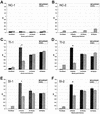OspE-related, OspF-related, and Elp lipoproteins are immunogenic in baboons experimentally infected with Borrelia burgdorferi and in human lyme disease patients
- PMID: 12409407
- PMCID: PMC139709
- DOI: 10.1128/JCM.40.11.4256-4265.2002
OspE-related, OspF-related, and Elp lipoproteins are immunogenic in baboons experimentally infected with Borrelia burgdorferi and in human lyme disease patients
Abstract
Presently, the rhesus macaque is the only nonhuman primate animal model utilized for the study of Lyme disease. While this animal model closely mimics human disease, rhesus macaques can harbor the herpes B virus, which is often lethal to humans; macaques also do not express the full complement of immunoglobulin G (IgG) subclasses found in humans. Conversely, baboons contain the full complement of IgG subclasses and do not harbor the herpes B virus. For these reasons, baboons have been increasingly utilized as the basis for models of infectious diseases and studies assessing the safety and immunogenicity of new vaccines. Here we analyzed the capability of baboons to become infected with Borrelia burgdorferi, the agent of Lyme disease. Combined culture and PCR analyses of tick- and syringe-infected animals indicated that baboons are a sufficient host for B. burgdorferi. Analysis of the antibody responses in infected baboons over a 48-week period revealed that antibodies are generated early during infection against many borrelial antigens, including the various OspE, OspF, and Elp paralogs that are encoded on the ubiquitous 32-kb circular plasmids (cp32s). By using the baboon sera generated by experimental infection it was determined that a combination of two cp32-encoded lipoproteins, OspE and ElpB1, resulted in highly specific and sensitive detection of B. burgdorferi infection. An expanded analysis, which included 39 different human Lyme disease patients, revealed that a combination of the OspE and ElpB1 lipoproteins could be the basis for a new serodiagnostic assay for Lyme disease. Importantly, this novel serodiagnostic test would be useful independent of prior OspA vaccination status.
Figures



Comment in
-
Improving the specificity of recombinant immunoassays for lyme disease.J Clin Microbiol. 2003 Jun;41(6):2791. doi: 10.1128/JCM.41.6.2791.2003. J Clin Microbiol. 2003. PMID: 12791934 Free PMC article. No abstract available.
References
-
- Akins, D. R., S. F. Porcella, T. G. Popova, D. Shevchenko, S. I. Baker, M. Li, M. V. Norgard, and J. D. Radolf. 1995. Evidence for in vivo but not in vitro expression of a Borrelia burgdorferi outer surface protein F (OspF) homolog. Mol. Microbiol. 18:507-520. - PubMed
-
- Arganaraz, E. R., G. B. Hubbard, L. A. Ramos, A. L. Ford, N. Nitz, M. M. Leland, J. L. Vandeberg, and A. R. Teixeira. 2001. Blood-sucking lice may disseminate Trypanosoma cruzi infection in baboons. Rev. Inst. Med. Trop. Sao Paulo 43:271-276. - PubMed
Publication types
MeSH terms
Substances
Grants and funding
LinkOut - more resources
Full Text Sources
Medical

